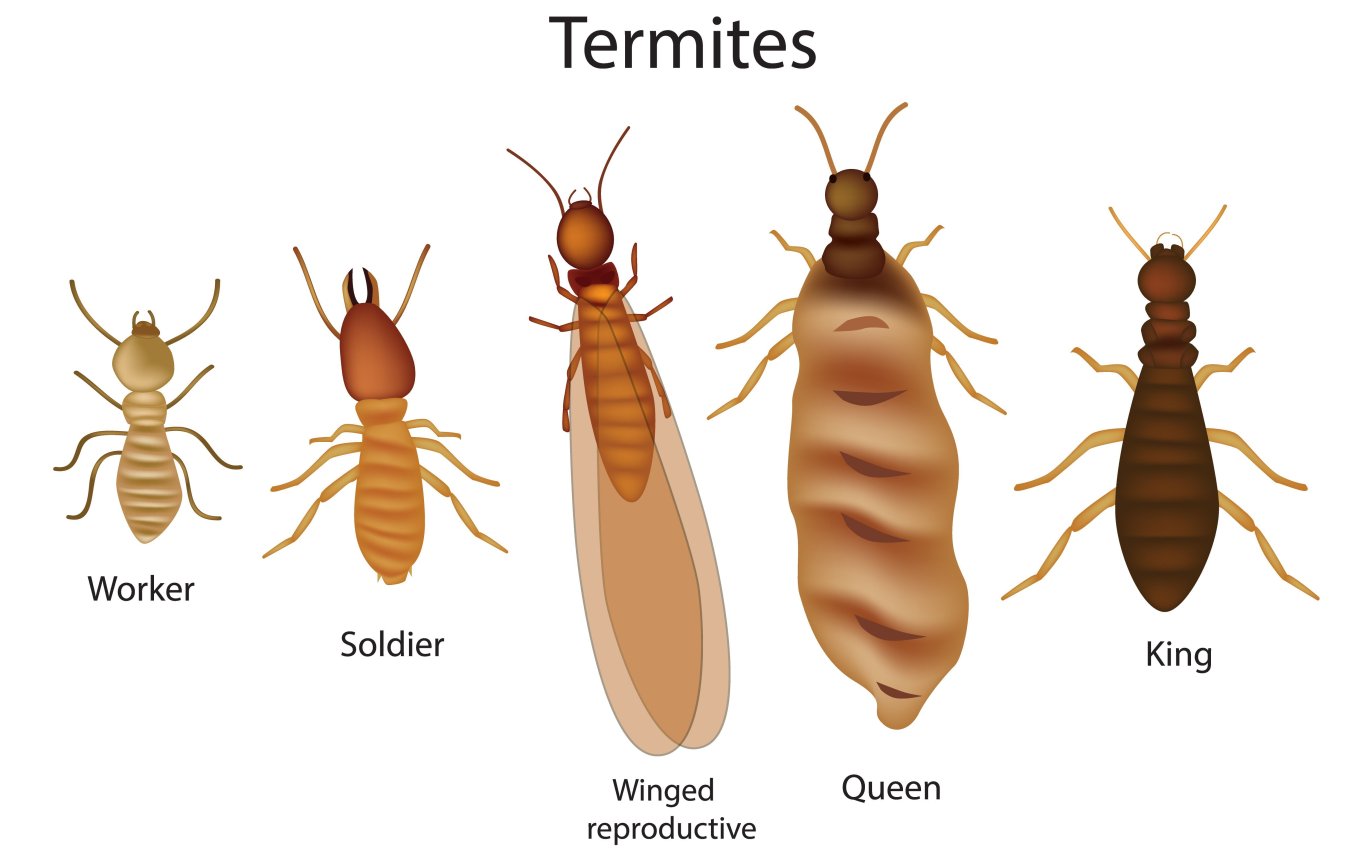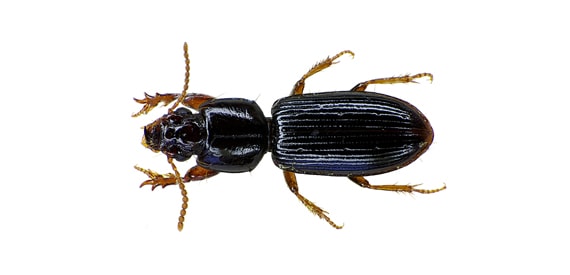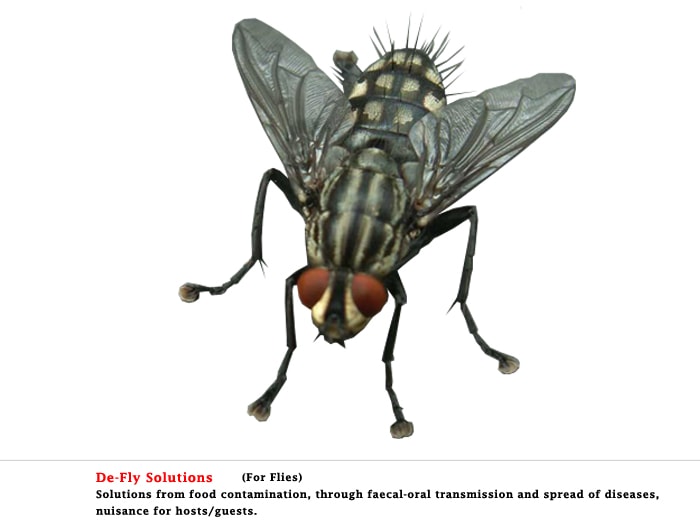Termites
Termites are highly social insects that live in colonies where populations can reach more than one million. A colony consists of several structurally differentiated forms living together as castes (including reproductives, soldiers, and workers) with different functions in the colony community life.
It is a colonial, social insect building colonies either above or below ground. The worker termites are best described as little white ants though they do not come under the family of ants. The termites travel back to soil colonies to maintain moisture, intestinal symbiont etc., and necessary for their existence.
It has strict cast system which includes a king, queen, workers, soldiers, and reproductives or alates (winged termites). The termite colony is maintained by division of labor among the caste.

Workers represent the majority and take care of eggs, constructing and maintaining tunnels/tubes, foraging for food and feeding and grooming of the other members. They are sterile and blind. They can forage through cracks and crevices in building as small as 1/64th of an inch.
Soldier is responsible for defending the colony which has two large jaws or mandibles used as a weapon against predators. They are sterile and blind.
Queen termite creates the colony by laying eggs and tending the colony until enough workers and nymphs are produced and keep producing thousands of eggs each day continuously during rest of the life.
King termite assists initially during the colony formation and continues to mate through out the life to help increase the colony size.
Alates swarm at certain times of the year in millions to establish new colonies. These winged females and males form pair bonds with male closely following the female in search of nesting location. Once they have paired they shed their wings and remain flightless developing the colony.
Life Span: Queen Termite can live between 10 to 15 years and worker and soldier termites can live up to 2-5 years.
Diet: Termite eats wood and other cellulose materials like paper, cloth etc which is digested with the help of bacterial or protozoan symbiont in their gut which is regained from the feces of another termites and do not need a water source.
Communication: Termites communicate by pheromone trials for others to follow when a new source of food is found, alarm pheromone that triggers the soldiers to attack, creates vibrations by banging their heads against the tunnels to mobilize the colony to defend itself. Mutual exchange of food supports colony members recognition.
De-termite Solutions
One year contract: initial treatment supported by check up visits.
Five year warranty: Post construction un-abutted buildings subject to feasibility to construct perfect continuous barrier internally and externally.
Ten Year warranty: Pre-construction un-abutted buildings subject to feasibility to construct perfect continuous barrier internally and externally.
Precautions
- Stack firewood at the far end of the garden.
- Make sure that leaves and garden waste arent stored next to the house.
- Ensure regular maintenance of taps and pipes.
- Provide good ventilation in crawl spaces.
 Wood Borer
Wood Borer
Wood borer are tiny beetles ranging from 2-7 mm also known as Powder post beetles. The life cycle consists of egg, larva, pupae and adult.
It is during the stage of larvae the wood is bored into, as a deep tunnel for the consumption of starch. The excreta of the organism falls like a fine yellowish talcum powder through pin head size tiny holes from the wood. They are able to turn the inside of a piece of wood into nothing more than a mass of powder.
Four important Woodborer families of order Coleoptera
- Lyctidae.
- Bostrichidae.
- Anobiidae.
- Cerambycidae.
Life span
1 to 5 years.
De-Woodborer Solutions
An oil base solution is injected in the holes created as result of damage caused by powder post beetles. The entire infested portion is then sprayed. This has to be followed once again after a fortnight.
Precautions
- Avoid buying wood which has pinholes and dust accumulation around it.
 Rodents
Rodents
Rodents due to their adaptation to different micro-habitats and abundant population has become serious threat to human health and properties Mostly being commensal ( sharing ones table) in human habitation, the effects of the left overs ranges from various diseases, contamination of food for pets, children and adults to damages in building structurals and food storages.
The common species found are
- House Mouse.
- Roof Rat.
- Norway Rat.
- Bandicoot Rat.
Lesser Bandicoot or Indian Mole Rat: Bandicota bengalensis
Larger/Greater Bandicoot Rat: Bandicota indica
Effects on Human
- The rodent incisors (first kind of tooth) grow 0.3 to 0.4mm each day which can become larger than the mouth resisting consuming the food. Hence the rodents grind the same to keep the growth under control, hence it nibbles all the materials concerned to human like wood, computer cables, wires etc.,
- Due to the food consumption similar to human, it contaminates by transferring the pathogens, urinating, droppings and fall of hair.
- Because of their close proximity to human, they are able to spread many dreaded and infectious diseases such as plague, Murine typhus, salmonellosis, rat bite fever, leptospirosis, typhoid and dysentery causing morbidity and mortality.
- They are good climbers and hence they can reach any heights of the building.
- They can make a species that depend on low resources for survival to extinct.
- Their body is so flexible which make them possible to squeeze through an entry point as small as ¼ of an inch.
Diet
They are omnivorous and can feed on every thing from fresh to garbage wastes.
Life Spant
At normal condition they can live up to one year and in the laboratory condition 2-3 years have been found possible.
De-Rat Solutions
Utilization of various trapping methods internally and baiting methods externally. Your De-rating professional can design suitable methods after inspection.
Precautions
- Close all the entry points.
- Avoid keeping the food uncovered.
- Avoid food spillage.
- Regular sanitation is necessary, as the rodents can survive in fewer resources.
- Use closed garbage bins and dispose the wastage in closed containers.
- Dried grain and meat products should be stored in glass jars, metal canisters or other resealable airtight containers.
- Dispose all the scraps which will avoid shelters for rodents.
- Clean the areas using anti-bacterial solutions if rodent droppings are found which can be source to spread diseases
 Cockroach
Cockroach
Cockroaches are one of the most commonly noted household pests which are among the hardiest insects on the planet. Some species are capable of remaining active for a month without food and are able to survive on limited resources and can go without air for 45 minutes. It is popularly suggested that cockroaches will "inherit the earth" if humanity destroys itself in a nuclear war.
Commonly found cockroaches
- Blattella germanica, German Cockroach.
- Periplaneta americana, American Cockroach.
- Supella longipalpa, Brown-banded Cockroach.
- Blatta orientalis, Oriental Cockroach.
| Cockroach |
German
Cockroach |
Oriental Cockroach |
American Cockroach |
Brown Banded Cockroach |
| Size | 12 mm (1.2 cm) to 15 mm (1.5 cm) | 25 mm (2.5 cm) to 30 mm (3.0 cm) | 28 mm (2.8 cm) to 43 mm (4.3 cm) | 10 to 15 mm long |
| Habitat | Heated buildings, optimum 32 °C(90 °F) | 20 °C (68 °F) to 29 °C (84 °F) | Same as German | temperatures below 75 F |
| Nymphal development | 6 to 12 weeks | 6 to 12 months | 4 to 15 months | 3 to 9 months |
| Life Span | 6 to 9 months | 1 to 1.5 years | 1 to 1.5 years | 5 to 6.5 months |
| Able to fly? | No | No | No | No |
| Reproduction | Each egg case contains 40 individual eggs and carries the egg case. | Each egg case contains 16 individual eggs. | Each egg case contains 16 individual eggs | Each egg case contains 14-18 individual eggs |
| Preferred locations | Kitchens, cracks and crevices, garbage | Sewers, drains, damp basements, porches, and other damp | Basements, crawl spaces, cracks and crevices of porches, foundations, and walkways adjacent to buildings, manholes, drainages | Bed rooms, Beneath tables, chairs, dressers and chests, closets, pictures, on rough plaster walls and ceilings |
| Diet | Fond of starches, sweets, grease, and meat products | Feed on garbage and decaying plant and animal products | Decaying organic matter and fond of fermenting foods | Glue, starch, certain color dyes |
Effects on Human
Contamination of food, Cockroaches has been reported to spread at least 33 kinds of bacteria, six kinds of parasitic worms, and at least seven other kinds of human pathogens. They can pick up germs on the spines of their legs and bodies as they crawl through decaying matter or sewage and then carry these into food or onto food surfaces.
Cockroaches have been shown to be linked with allergic reactions in humans. One of the proteins that trigger allergic reactions has been identified as tropomyosin. These allergens have also been found to be linked with asthma.
De-Cockroach solutions
Suggestion for non-chemical measures and utilizing suitable odorless chemicals. Annual maintenance contract are preferable to have continuous monitoring and population control and to avoid re-infestation.
Precautions
- Avoid keeping food materials open.
- Keep closed soiled plates.
- Seal all the cracks and crevices.
 Flies
House Flies
Flies
House Flies
These flies normally breed around human habitation during the summer. House flies feed on moist organic matter feces, sputum. They only take liquid foods by spitting our saliva on the solid foods to predigest and suck them back in. A single house fly can carry over one million bacteria.
They do accomplish a complete metamorphosis and the adult lives from 2 weeks to one month.
The are serious threat to public health because of the transmission of bacterial diseases like typhoid, cholera, dysentery, pyogenic cocci, parasitic diseases like Entamoeba histolytica and Viral diseases like poliomyelitis. They are capable of carrying pathogens such as typhoid, cholera, salmonella, bacillary dysentery, tuberculosis, anthrax, ophthalmia, and parasitic worms.
Flesh Flies
These are larger than common house fly which breeds in carcass of a dead animal, dung, decaying material. Flesh flies lays eggs on the corpses of human or any dead animal and their larva eats decaying matter and excrement found around latrine pits or discarded compost.
Flesh flies can carry leprosy bacilli and can transmit intestinal pseudomyiasis to people who eat in complete boiled food.
Precautions
- Ensure Garbage cans and dumpsters with closed lids.
- Dispose all the empty containers, kitchen waste in closed lid garbage cans.
- Regular cleaning of pets feces and other food spillages.
- Immediately remove the dead matter/animal found around the premises.
- Tight fitting window screens are recommended.
- The disposal from your home to be packed in plastic bags to avoid spillages.
Chemicals Methods
Suggest to discuss with a de-pest professional.
 Mosquitoes
Mosquitoes
Mosquitoes are one of the most important insects that transmit various types of communicable diseases such as malaria, Filaria, Japanese encephalitis, Dengue & Chikungunya. The common genuses of mosquitoes noticed are Anopheles, Culex and Aedes. These mosquitoes have specific breeding and resting preferences. Mosquitoes lay eggs in water and the aquatic stages of mosquitoes spends part of its life (6-10 days) in water. Once the adult emerge out of water they would be in search of suitable host for blood feeding without which the mosquitoes cannot lay fertile eggs.
Due to increase in the open drains, dumping of plastics, improper disposal of broken consumer goods along with climatic warming supports the increase in mosquito population. Due to the increasing frequency of overseas travel, import of labour and decreasing effectiveness of both anti-malarial drugs against malaria parasites and insecticides against mosquitoes, the transmission of diseases like malaria, chikungunya etc cannot be avoided without controlling mosquitoes.
Hence elimination of mosquito breeding sources and modification of habitats along with reduction in the adult mosquito population is of primary importance for our healthy life.
De-mosquito Solutions
The basic approaches to de-mosquito the population is elimination of breeding sites, elimination of larvae, elimination of adults, and deterring the insects from biting.
Mosquito larval stages depending on the genus develop in polluted stagnant water, potable water or water that stagnates in disused bottles, cans, plastic cups, gutters, rainwater butts, discarded tyres. Removal of rubbish obstructing the water flow in the drain channels can greatly reduce the numbers of urban mosquitoes.
A gentle smear of oil in the water surface of the drain channel reduces the population of mosquitoes.
However the regular usage of pesticides inside the residences is restricted as last line of action. Mosquito proofing along with common available vaporizers can be continued for reducing the adult mosquitoes.
A discussion with a professional in mosquito management is suggested.


 Bed Bugs
Bed Bugs
Bed bugs migrate through hiding in suitcases, boxes and shoes to the next food available sources. They feed only on blood of humans and other warm blooded hosts. They can survive without food for months. Hence keeping the house vacant or continuous travel with the infested baggage would not reduce bedbug infestation.
They have cryptic behavior which makes them conceal in cracks and crevices, electrical switch plates, wall papers, car seats, folded beads, furniture, mattresses etc.,
Bed bugs usually require 5-10 minutes to engorge with blood. They suck the blood almost 2 to 3 times of their body weight and seclude themselves by hiding for 5 to 10 days by digesting this meal, mating and laying eggs.
De-bug Solutions
Non-chemical solutions:
Vacuuming all the hiding places after proper visual inspections and washing the cloth in hot water.
Chemical solutions:
A discussion with a professional in bed bug management is suggested.
Precautions
- Avoid buying second hand furniture, mattress.
- Cover your suitcase with plastic trash bag during the stays outside your home.
- Check you baggage before you place inside your home.